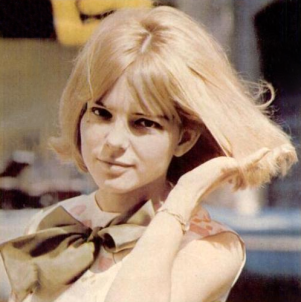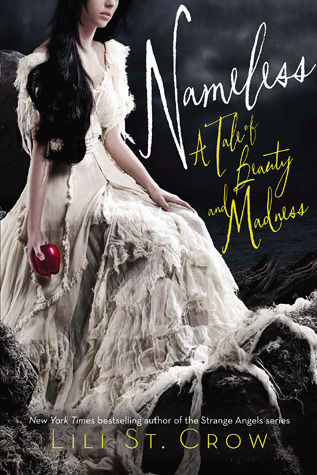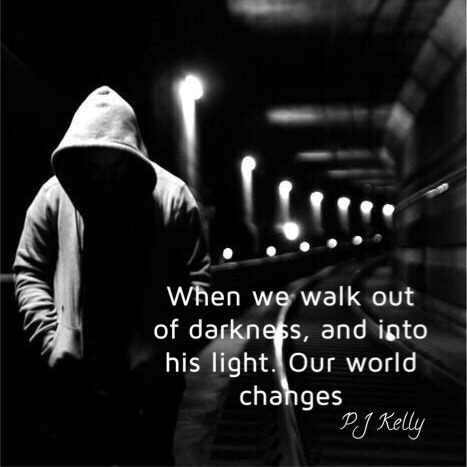By Drew Baumgartner and Patrick Ehlers

This article contains SPOILERS. If you haven’t read the issue yet, proceed at your own risk!

Drew: What moral do we take away from heroic self-sacrifice? We undoubtedly see nobility in a hero prizing the life and safety of others more than their own, but our own takeaway is likely much more modest — we might sacrifice our material comfort or time for the benefit of others, if not our lives. But is “self-sacrifice is good” the only way to look at those stories? Is it possible to look at a hero laying down their life for others and identify with those others — not the hero making the sacrifice, but the beneficiaries of that sacrifice? Is it possible that we see the hero’s death less as a noble choice and more as satisfying a cosmic need for heroes to die — a “sacrifice” in a very different sense of the word? It’s the kind of conclusion you might expect of a world-ending sci-fi computer to draw, but it’s also embedded in the idiosyncratic resolution of John Layman and Sam Kieth’s Eleanor and the Egret.
Or so my argument goes. This is a reading I’m less than confident in, but it’s also the one that has me most excited. It all hinges on Ellis’s metaphorical role in the narrative.
We’d always understood Eleanor and the Egret as the story of an art thief, but as the series wore on, we learned that the thievery in question was less about Eleanor and Ellis stealing paintings, and more about Anastasia Rüe stealing Eleanor’s abilities. It’s the kind of theft we might dismiss as comic-book-y silliness — the villain stealing the powers of the hero — but it doesn’t take much to reframe this as the story of the establishment stealing the creative power of young artists. Rüe (perhaps playing the role of a major comics publisher) made a home for creative types of all kinds, but ultimately took their creativity as her own, leaving them with nothing, all while she was reveling in her fame and fortune. It’s easy for me to see this as an airing of grievances against the kind of IP claims publishers often make of characters created and developed by freelancers while under contract. Rüe may have literally taken Eleanor’s ability (or will) to paint, but it’s not too far off from publishers claiming a creators’ characters and ideas as their own.
For me, the strongest evidence for this reading lies in Rüe’s material success. Her victims languish in obscurity while she luxuriates in a high-rise apartment/office, waited on hand and foot by servants.

She can dismiss Eleanor as “a schlubby little nobody” only because she has taken credit for Eleanor’s creativity. She has used Eleanor’s abilities to get rich, but refuses to acknowledge Eleanor or those abilities.
So if Eleanor is the struggling artist and Rüe is the corporate force exploiting her, where does that leave Ellis? It might be tempting to categorize Ellis as part of the magical tapestry of this series, a cartoony detail with no bearing on the metaphor I laid out above, but his sacrifice is too central to the resolution of this story to chalk up to nonsense. I struggled with his placement in this reading for a good long while until I remembered his role as a literal consumer of Rüe’s artwork. In that light, his sacrifice suddenly snaps into place as the only way for Eleanor (and artists like her) to succeed: with the death of the consumers that support her corporate exploiters. That’s death in a figurative sense, mind you, but it lays out Ellis less as a heroic figure and more as a figure who needed to die in order for good to triumph over evil.
Okay, that language may be a little over-the-top for a reading that amounts to “entertainment companies rely on an exploited creative class,” but I’m struck at how Ellis’s sacrifice changes under this reading. We don’t want to be like Ellis, we want to kill whatever piece of Ellis exists in us, so that we might also benefit from his sacrifice. Even that might be making the point too strongly, but I can’t shake this reading, even if I lack the language to precisely articulate it.
Patrick, I’m excited to hear your thoughts on this reading, but I’m also hoping you can steer us back towards what’s actually in the issue — I can’t believe I burned through my word count without properly mentioning Kieth’s varied style or Ronda Pattison’s evocative color work. What jumped out to you in this issue?

Patrick: That’s a really interesting read, Drew, and I wonder what that reading does when applied to the story’s epilogue. A handful of blotchy, black and white watercolor pages separate the meat of this story from an extremely understated epilogue. In it, Eleanor wraps up a painting of herself riding Ellis, tiny pink heart filling the space between them. In so doing, she turns the artist — herself — and the consumer of the art — Ellis — into the subject of the art. It’s the kind of collapsing of the corporate art model that Drew writes about above. It is also some of Kieth and Pattison’s strongest work.

I love that those hearts only appear in the second panel. There are no rules dictating what that means — are we seeing the image as it exists in the painter’s eyes? The viewer’s eyes? Are we somehow zooming in to an absolute truth? Note that right-most heart actually traverses the panel divider, just like that FIN banner, so maybe that’s a private message of love from the creators of this work of art (i.e., Kieth) to this viewer (i.e., you and me).
There’s actually a lot of these kinds of non-diagetic cues that by-pass the characters and go right from the creator to the reader. When Eleanor smashes the first of Anastasia’s eggs, Rüe visually warps, evoking the style of an artist Kieth is more than happy to name-check right on the page.
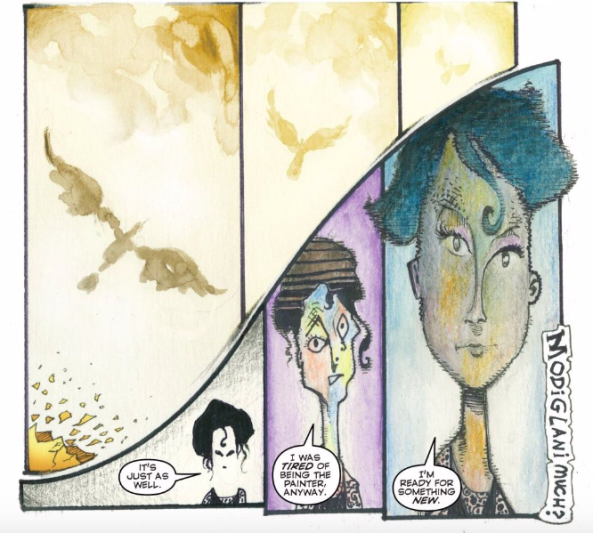
Err, sorta name check. I’ve only seen Amedeo Modigliani’s name spelled with one more i than Kieth is using here. I’m trying to determine what — if anything — that misspelling means. Is it indicative of Rüe’s disrespect for the artist? Or does it maybe insist on the purity of Kieth’s affection for the artist? There’s something very relatable about loving a piece of art, but only being about 90% certain of its origins. (Or at least, that’s very relatable for someone who writes about comic books every day.) I suppose, if nothing else, it forces the reader to engage with this extra piece of information for a second longer, conceding to google that, yes I did mean “Modigliani.”
Elsewhere, Kieth’s direct-to-the-reader cues are a little more obvious, and sometimes achingly literal. During the bookends of this story, we’re treated to Kwitch’s bat, at turns sad and happy, but always clearly labeled.
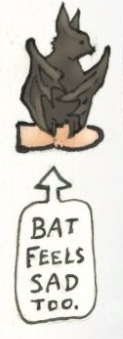
Maybe Kieth is just restricted by the acting range of a bat, but there’s something so endearing about carefully laying out the emotions of animals while leaving the human emotional experience relatively obtuse. Of course, maybe that’s the whole point: we have to outright state that the bat is sad or the bat is happy, while the experience of the artist can be more subtly expressed through their art. That’s what we see in the final page of the story proper: human being plying their art — be it math or dance or drawing — and expressing something. Anything. The point where that ends, and the expression is nothing more than death, is when the art form is theft.

So the moral, such as it is, is make art, consume art, love art. Just don’t steal it.

For a complete list of what we’re reading, head on over to our Pull List page. Whenever possible, buy your comics from your local mom and pop comic bookstore. If you want to rock digital copies, head on over to Comixology and download issues there. There’s no need to pirate, right?
Advertisements Share this:
